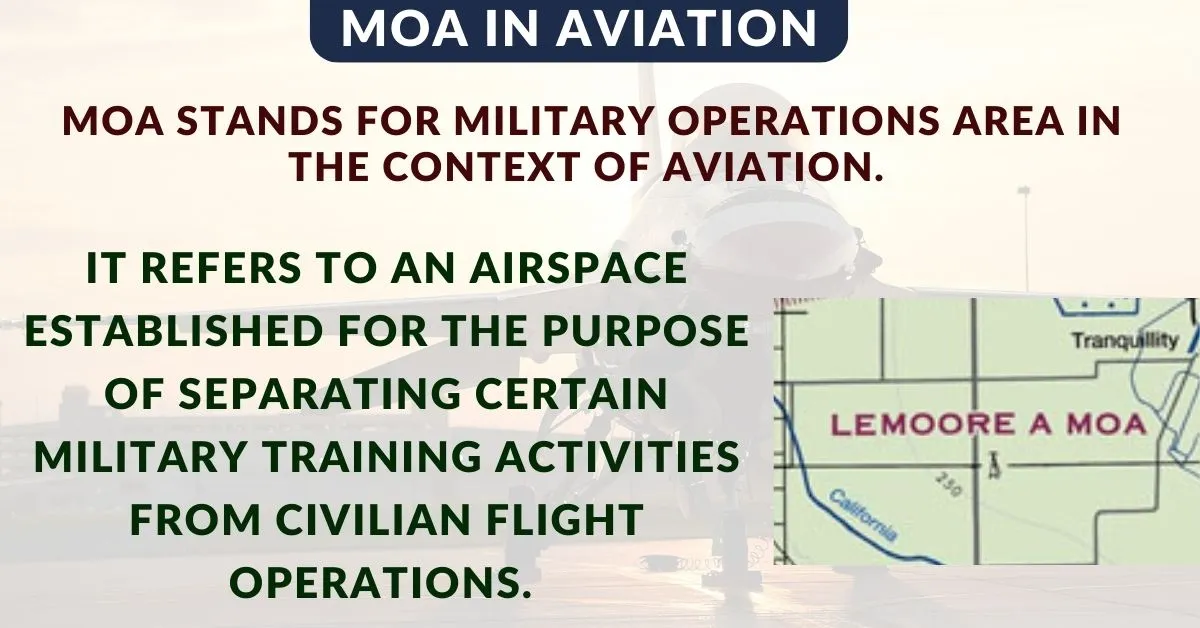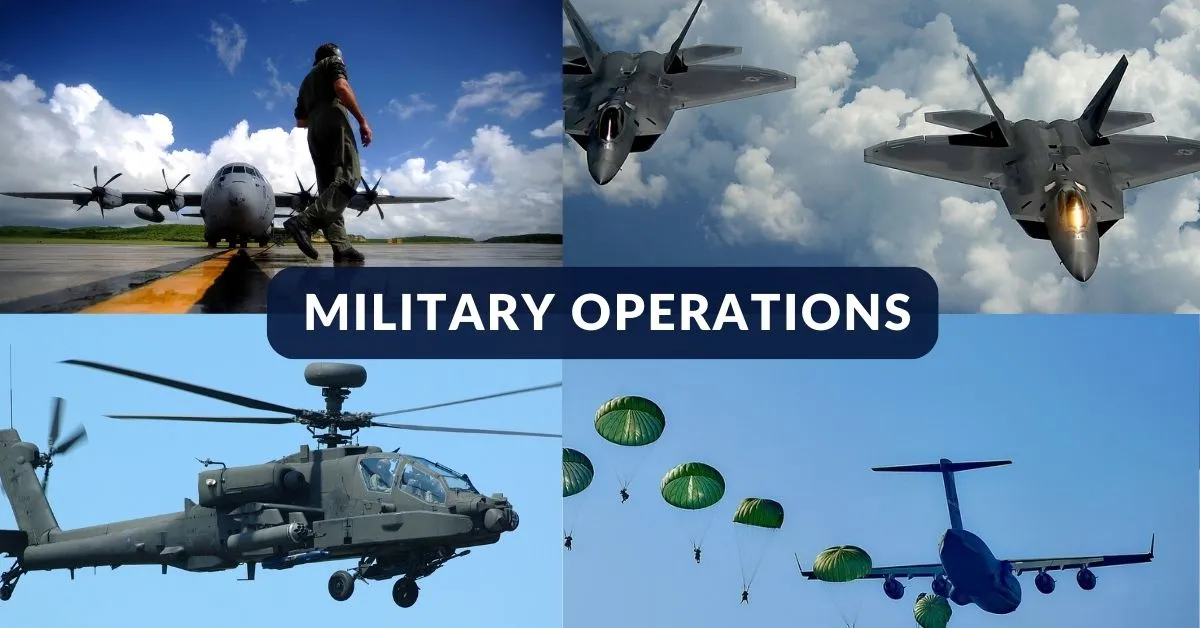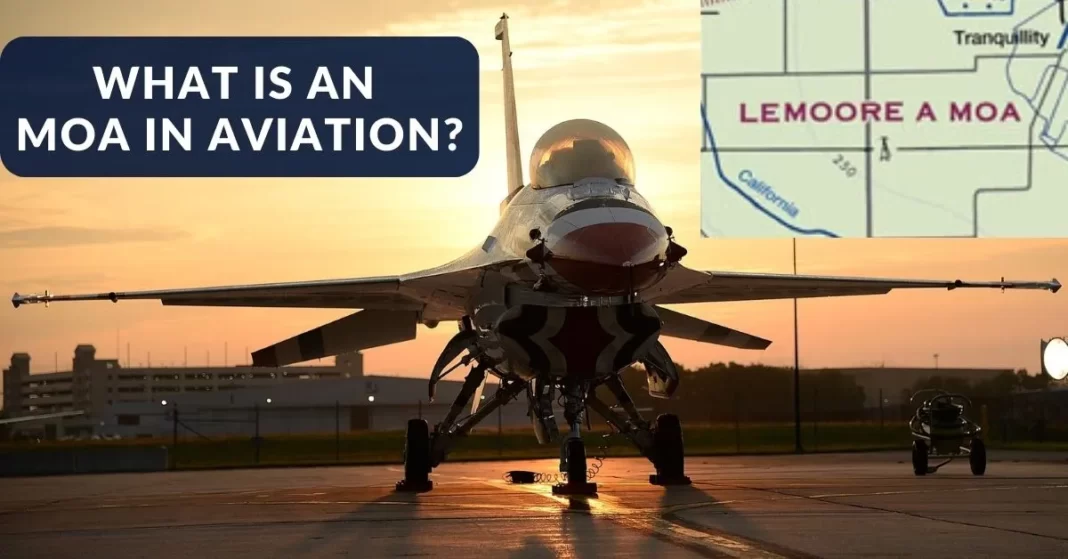Knowing about the many words and rules in aviation isn’t just for pilots or industry experts. Regular people can also learn a lot from understanding these ideas. One important thing to learn about is the Military Operations Area (MOA). It’s really important for how air travel works and how to keep it safe.
This exploration aims to make clear what the Military Operations Area (MOA) is, why it’s important in aviation, and how it’s different from other types of airspace. We want to help you understand the MOA’s important job in the world of aviation.
Table of Contents
Finding out what is an MOA in Aviation world.
MOA stands for Military Operations Area in the context of aviation. It refers to an airspace established for the purpose of separating certain military training activities from civilian flight operations.
MOAs are typically reserved for the use of the military for activities such as air combat tactics, air interceptions, aerobatics, and low-altitude tactics. Though primarily designed for military uses, they can also accommodate non-military flight activities as well, as per the regulations and understandings between air traffic control (ATC) and the military.
Characteristics and Specifications of MOA
MOAs are designated with defined vertical and lateral limits set by altitude and geographic markers. The airspace within an MOA may start from the surface of the earth and go up to 18,000 feet above sea level. Some MOAs can also range higher, often overlapping with airways (popular commercial flight paths), turning busy airways into shared airspace where military and civilian aircraft coexist.
The schedules for operations within an MOA are not always fixed. They can be intermittent, which means that the airspace might be used for military training at specific times and remain open to civilian aircraft at other times. Regardless of the schedule of operation, MOAs are charted for pilots’ awareness.
Purpose and Functionality of MOA
The main purpose of a Military Operations Area is to ensure the safe and efficient use of airspace by both military and non-military aircraft. They are designed to contain high-energy military activities that could pose potential hazards to non-participating aircraft. By segmenting these military training areas and operations, aircraft controllers are able to prevent interference or collision between civilian and military aircraft.
Beyond Regulatory Bodies and Their Impact on Aviation
The critical role of the Federal Aviation Administration (FAA) extends to the creation, regulation, and supervision of MOAs, often working in tandem with the Department of Defense (DOD) and other military entities. Despite the FAA having jurisdiction over all U.S. airspace including MOAs, it’s noteworthy that the military holds the power to manage activities within these particular niches.
The FAA instructs air traffic controllers to redirect or forewarn civilian aircraft about military operations in an active MOA. However, in the absence of active military operations, civilian airplanes can traverse these airspaces freely.
Importantly, the onus lies on the pilot to check the status of an MOA before entry. Pilots are encouraged by the FAA to directly reach out to the controlling authority for the latest updates concerning an MOA’s status and activity.

The Importance and Application of MOA in Aviation
MOA plays an Integral Role in Aviation Safety
What’s known as a Military Operations Area (MOA) is a specially designed airspace defined within the United States to enable the segregation of military training exercises from Instrument Flight Rules (IFR) traffic.
The strategic setup of MOAs enhances the safety of civilian aircraft during military operations. While these designated MOAs don’t outright prohibit civilian flights, being mindful of their existence is essential for all pilots in the interest of enhanced safety.
Working Principle of MOA in Aviation
In the context of aviation, an MOA airspace is often created to accommodate military maneuvers and high-intensity training. MOAs are established by the Federal Aviation Administration (FAA) and the Department of Defense to permit acrobatic or abrupt flight maneuvers in areas not frequented by civilian aircraft. They act as invisible fences, providing a safety buffer that separates military and non-military aircraft.
When an MOA is active, the air traffic control (ATC) may need to reroute or delay civil, instrument-rated airplanes from these regions, or pilots can be allowed to self-separate and self-observe to navigate through them. However, it is pertinent for pilots to remain in constant contact with ATC when passing through these zones.
Application of MOA in Real-world Aviation
In real-world aviation, the application of MOAs is manifold. It serves as a training region for military pilots to practice maneuvers, combat tactics, air intercepts, acrobatics, and similar operations. Conversely, it also ensures that these operations do not interfere with non-participating IFR traffic routes.
Besides, MOAs provide a defined and safe space for test flights and weapon testing. Hence, even though an MOA does not limit non-participating pilots from traversing its space, awareness and avoidance of active MOAs reduce the potential for mid-air encounters between civilian and military aircraft.
Safety Considerations in MOA
Safety remains the most crucial aspect of aviation, and MOAs have a consequential role to play in this regard. Since MOAs involve high-speed military operations, which often include sudden and rapid altitude changes, unpredictable changes in direction, and formation flying, collision avoidance becomes a matter of extreme priority.
To ensure safety, pilots are usually advised to contact the controlling agency for traffic advisories prior to entering an active MOA. The FAA requires military activities to be suspended when a civilian aircraft is flying under IFR regulations in an MOA, ensuring clearer airspace for non-military flights.
Furthermore, pilots are encouraged to utilize onboard systems such as Traffic Collision Avoidance Systems (TCAS) and Automatic Dependent Surveillance-Broadcast (ADS-B) for enhanced situational awareness while operating near or within MOAs.
All elements of airspace management, especially Military Operations Areas (MOAs), play a critical role in preserving the safety and efficiency of both military and civilian aviation. The proper understanding and usage of MOAs is, therefore, of utmost importance.

MOA and Other Airspaces: The Differences
Understanding Military Operations Areas (MOA) in Aviation
A Military Operations Area (MOA) is a sector of airspace defined by the Federal Aviation Administration (FAA). It is within these areas that military drills, including dogfighting or live fire, typically take place. MOAs are designated primarily to segregate these military activities from Instrument Flight Rules (IFR) traffic lanes. While MOAs are not classified as restricted airspace, it is strongly recommended that pilots proceed with heightened vigilance when navigating through or near these areas.
Commonly located over more remote rural areas, MOAs span from the ground or near-ground level up to an altitude generally used by IFR aircraft. Despite not being restricted to Visual Flight Rules (VFR) aeronautical charts, pilots engaged in visual flights are still encouraged to operate under a standard of elevated caution.
The Air Traffic Control (ATC) facilitates pilots flying under IFR through an MOA with minimal disturbance or redirection. On the other hand, civilian pilots operating under VFR can transit through an MOA without an ATC clearance, yet, they might face a higher level of risk due to the potential military activities in these areas.
Comparison between MOA and Other Types of Airspace
The difference between an MOA and other airspace types such as Restricted, Prohibited, Controlled, and Uncontrolled airspaces primarily lies in their regulations and the activities they accommodate.
- Restricted Airspaces: Restricted airspaces are areas where flight is entirely prohibited or limited under certain conditions for reasons of national security or safety. They are usually designated due to ongoing ground activities that can be dangerous to aircraft.
- Prohibited Airspace: Prohibited airspaces are established for security-based reasons and house national landmarks, nuclear facilities, military installations, and other sensitive areas. Aircraft cannot fly in these airspaces without proper clearance or permission from the FAA.
- Controlled Airspace: This is a generic term that covers the differing classifications of airspace and defines the extent of air traffic control service provided. Classifications include Class A, B, C, D, and E airspaces.
- Uncontrolled Airspace: This is the opposite of controlled airspace. It refers to any region where an Air Traffic Service (ATS) is not deemed necessary or cannot be provided for whatever reason.
While each type of airspace serves a unique purpose, MOAs allow significant military operations to take place without obstructing civilian air traffic. Compared to an MOA, Prohibited or Restricted Airspaces are the most stringent and regulated and provide the highest level of operational safety, even though they limit the flow of civil aircraft traffic.
Meanwhile, Controlled Airspaces offer flexibility, and differing restrictions based on their specific classes, and Uncontrolled Airspaces provide minimal to no regulation, allowing free movement of aircraft. In essence, it’s crucial to understand these distinctions when talking about MOAs as they highlight the balance between military operations and seamless civilian air traffic.
With a thorough understanding of MOAs, they can be seen not only as navigational and communication tools but as essential safety measures ensuring the smooth operation of military and civilian aircraft in harmony.
Conclusion on ‘What is an MOA in Aviation?’
As we come to the end of this informative blog on MOAs in Aviation, we explored almost all the technical as well as fundamental details related to this terminology in the aviation industry.
Let’s end our discussion with some key points listed below.
- MOAs are areas of airspace where the military conducts training exercises. They are established outside of Class A airspace to separate military aircraft from IFR traffic and to identify the areas where training is taking place for VFR pilots.
- MOAs are established to contain a variety of non-hazardous military flight activities, such as air combat maneuvers, air intercepts, and low-altitude tactics.
- Military Operations Areas (MOAs) can stretch beneath 1,200 feet above ground level (AGL) given the presence of mission prerequisites and minimal negative impact on aviation.
- MOAs must be situated in a way that causes the least possible disruption to operations of nonparticipating aircraft. MOAs are not allowed to be established offshore past the 12 nautical mile territorial boundary of the United States.
- MOAs can be set up within Class G airspace. The agencies in charge and pilots engaging in activities within these MOAs should acknowledge that other aircraft not involved in the exercises have the legal right to operate under IFR or VFR without requiring an Air Traffic Control clearance in this airspace.





